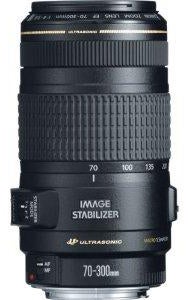Supported by a three-stop Image Stabilisation system and UD elements, this lens is capable of impressive results
Canon EF 70-300mm f/4-5.6 IS USM Review
Canon’s lens is priced close to the £500 budget limit but offers a lot in return. Not only is there a quick and accurate USM focusing mechanism but also image stabilisation that offers single-axis and dual-axis modes to accommodate both panning and static photography.
The zoom ring occupies the centre section of the lens barrel and is perfectly located for comfortable use at any focal length. This is important because the forward-positioned focus ring rotates in AF mode so fingers must not be allowed to creep toward the front of the lens unless MF mode is engaged. Both rings have a relatively light action but when the lens is turned upwards, say to photograph an air display, the zooming action becomes slightly jerky. At near-vertical angles, the zoom tends to contract under its own weight.
Immediately behind the zoom ring are slider switches to activate the Image Stabilizer and to select the most appropriate mode. Neither slider is particularly easy to move, so these settings are unlikely to be disturbed when stowing or retrieving the camera from a bag. As the AF/MF slider is slightly more exposed, it might be dislodged when attaching or removing the lens.
The front of the lens rotates during focusing, undermining any careful alignment of filters that may need to be maintained at different distances. For the price, this is a predictable compromise.
MTF testing revealed impressive results across the zoom range, with just the maximum focal-length proving slightly weaker. Provided that the lens is stopped-down no further than f/16 (f/11 at 300mm) there is likely to be full sharpness as the MTF figures remain above the critical 0.25 cycles-per-pixel level. Conversely, selecting minimum aperture will degrade image quality and it is a shame that Canon did not simply limit this to f/32 at all focal lengths rather than allowing the setting to shrink to f/45 at 300mm.

Verdict
It may have a relatively old design, but this optic produces a great set of MTF curves at all focal lengths, with just a dip at 300mm when smaller apertures are used. If you can avoid these performance here is still very acceptable.





